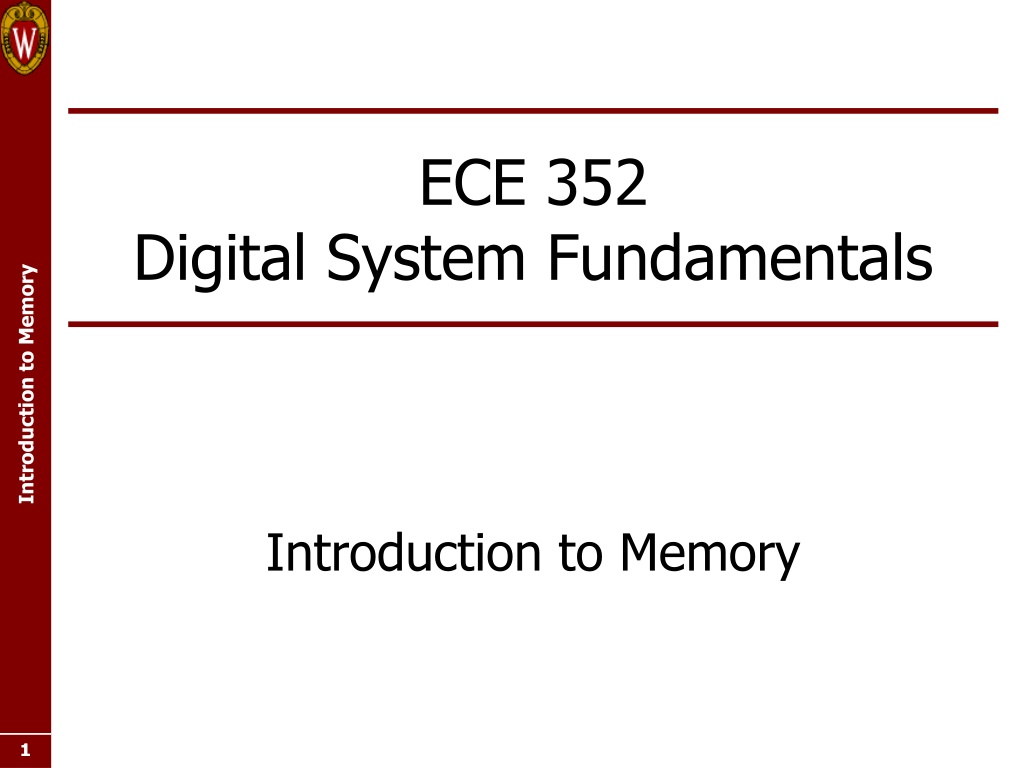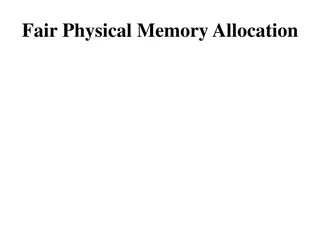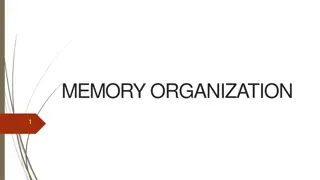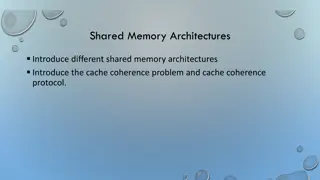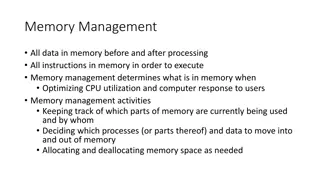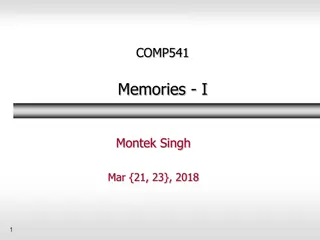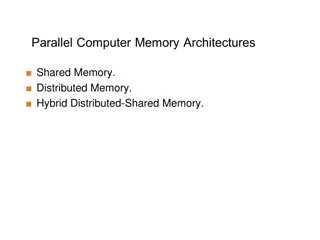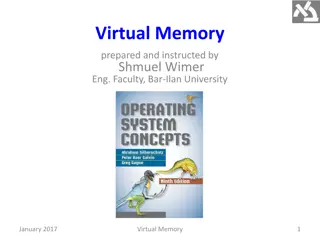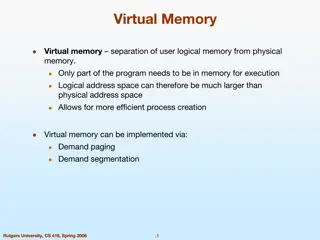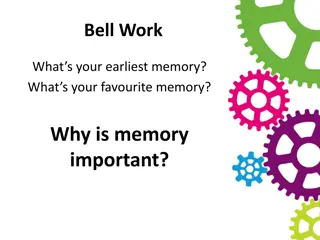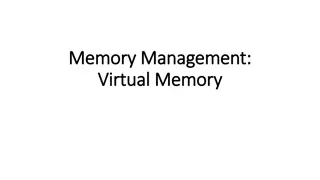Memory Basics in Digital Systems
Dive into the world of digital memory systems with a focus on Random Access Memory (RAM), memory capacities, SI prefixes, logical models of memory, and example memory symbols. Learn about word sizes, addresses, data transfer, and capacity calculations to gain a comprehensive understanding of memory fundamentals. Explore how memory storage works and the importance of proper addressing and control signals for read and write operations.
Download Presentation

Please find below an Image/Link to download the presentation.
The content on the website is provided AS IS for your information and personal use only. It may not be sold, licensed, or shared on other websites without obtaining consent from the author.If you encounter any issues during the download, it is possible that the publisher has removed the file from their server.
You are allowed to download the files provided on this website for personal or commercial use, subject to the condition that they are used lawfully. All files are the property of their respective owners.
The content on the website is provided AS IS for your information and personal use only. It may not be sold, licensed, or shared on other websites without obtaining consent from the author.
E N D
Presentation Transcript
ECE 352 Digital System Fundamentals Introduction to Memory Introduction to Memory 1 1
Random Access Memory (RAM) Information stored as groups of bits (words) A group of 8 bits is a byte A group of 4 bits is a nibble (or nybble ) The capacity of a memory is the total number of bits it can store Also stated numwords x wordsize (depth x width) The SI prefixes (K, M, G, T, P) are used, BUT K = 210, M = 220, G = 230, T = 240, P = 250 A kilobyte is 1024 bytes, not 1000 bytes! Note that this can be confusing and lead to errors Communications systems typically use the actual SI prefix meanings, so a 1 kb/s communication link can only transmit 1,000 bits per second, not 1,024 bits per second! See http://physics.nist.gov/cuu/Units/binary.html Introduction to Memory 2 2
A Logical Model of Memory An m x n memory is similar (logically) to a register file with m registers, each n bits in size Locations accessed using a k-bit address (m 2k) Reading: chooses which register value appears at output Writing: chooses which register to enable Data is transferred on an n-bit input port (for writes) and an n-bit output port (for reads) Or a single n-bit bidirectional data port Control signals indicate if it should read or write May have separate read and write signals, or a single R/W signal (read when 1, write when 0) May include a chip select that acts as an enable on both the read and write operations (DOUTmust be tristated ) Introduction to Memory 3 3
Example Memory Symbol # of words (m 2k) Introduction to Memory word size indicates DOUT not driven if CS = 0 m n SRAM n k data input DIN ADR address n DOUT data output chip select CS read/write R/W 4 4
Example Memory Symbol 8192 words, each of which is 16 bits wide # of words Introduction to Memory word size 8K 16 SRAM 8K 16 SRAM 16 DIN ADR # address bits = log2(8K) = log2(213) = 13 13 16 DOUT CS R/W 27 210 Total capacity = 8K 16 = (8 210) 16 = 23 210 24= 217= 128K bits 5 5
Read From Memory Apply desired address Enable memory and activate read signal Some designs: memory continually reads Other designs: memory continually reads when not writing Data driven onto DOUT port after some time Often more than one processor cycle m n SRAM n k DIN ADR Introduction to Memory n DOUT CS R/W memory access time ADR CS R/W DOUT DOUT DOUT DOUT ADR CS R/W R/W R/W ADR CS CS ADR address valid address valid address valid address valid data valid data valid data valid data valid R/W = 1 the whole time to avoid writing 6 6
Write To Memory Apply desired address and enable memory Apply data to the data input and activate write signal After data has been written, deactivate write signal After that, the data/address are allowed to change and can disable memory m n SRAM n k DIN ADR Introduction to Memory n DOUT CS R/W memory write cycle time ADR CS R/W R/W R/W R/W ADR CS R/W DIN DIN DIN DIN DIN ADR CS CS CS ADR ADR address valid address valid address valid address valid address valid Must avoid writing incorrect data and/or to incorrect location! data valid data valid data valid data valid data valid 7 7
Memory Cells There are two different storage mechanisms used to hold a single bit in RAM devices Static RAM (SRAM) select Dynamic RAM (DRAM) select Introduction to Memory Q B D Each bit stored in a latch or flip-flop As long as power is applied, data is held Each bit stored as a charge in a capacitor Leaks charge over time Value must be periodically refreshed by reading it back, then re-writing it 8 8
DRAM Devices More complicated than SRAM, but also smaller Has more capacity within a given area (cheaper!) Due to their large capacity, DRAMs typically use multiplexed addressing Conceptually rearrange memory into a 2D grid Instead of using a single large address, use separate row and column addresses to identify a word Send each part of the address separately to the DRAM Row/column addresses are held in registers in the DRAM device & used together to access memory word This makes DRAM addressing more complex! Introduction to Memory 9 9
Memory Properties & Terminology Memory may be static or dynamic Refers to the design of the memory cell (shown earlier) Introduction to Memory Volatile memory loses its contents when power is removed Includes both static and dynamic memory Nonvolatile memory retains information when power is removed (flash, optical, magnetic, etc.) 10 10
Memory Properties & Terminology Some commonly-used memory terms are misnomers! Random Access Memory (RAM) Requires same amount of time to access any location What would a sequential-access memory look like? We use this name to mean we can read and write during normal operation Introduction to Memory Read Only Memory (ROM) Can only read during normal operation We use this to mean a non-volatile memory 11 11
ECE 352 Digital System Fundamentals Introduction to Memory Introduction to Memory 12 12
